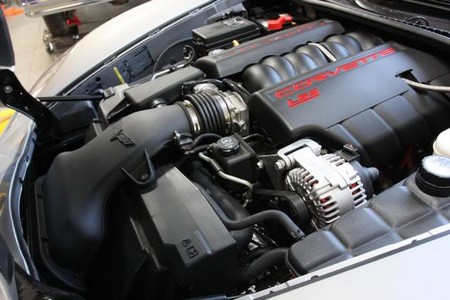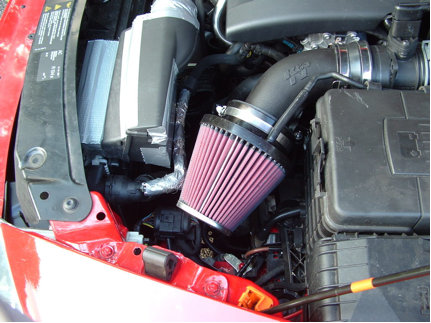Most engines with carburetors have a heated-air inlet system integrated into the air-filter housing. This system is sometimes referred to as THER-MAC, an acronym for thermostatic air cleaner, or EFE, an acronym for early fuel evaporation. The system raises the temperature of air to about 105°F before the air mixes with gasoline in the carburetor. Warming of the fuel mixture cuts down on the amount of carbon monoxide that is expelled from the engine through the exhaust system. Carbon monoxide is an air pollutant. A heated-air inlet system consists of a valve plate, a vacuum diaphragm, and a heat-sensing switch. All are located in the air-filter housing. Each must function properly to maintain sound engine performance.

In most engines, the valve plate is inside the long nose (or snorkel) of the air-filter housing. The vacuum diaphragm is on top of the snorkel. The heat-sensing switch is inside the air-filter housing.
The vacuum diaphragm controls the closing and opening of the valve plate. The heat-sensing switch transmits “orders” to the diaphragm as to when the valve plate should be closed and opened.
The vacuum diaphragm works to keep the valve plate closed so it blocks the flow of air to the carburetor when the temperature of the air is less than 105°F. Instead, the air that the engine needs to run properly until it warms up is drawn into the carburetor from the exhaust manifold through an opening in the underside of the air-filter housing..
As the engine warms up and raises air temperature to above 105°F, the heat-sensing switch orders the vacuum diaphragm to release its hold on the valve plate. The plate opens to let air, now heated, reach the carburetor. When the plate drops, it falls over and seals the opening in the snorkel through which hot air from the exhaust manifold had been getting to the carburetor.
If the system isn’t working right, the valve plate can stay open when it should close. This will allow cold air to enter the carburetor, causing the engine to hesitate on acceleration and/or stall. Conversely, if the valve plate stays closed when it should open, the air from the exhaust manifold, which becomes increasingly hot as the engine warms up, will mix with gasoline. The mixture can get hot enough to start burning prematurely. This will result in detonation.
To determine whether one or more parts of a heated-air inlet system are causing a performance problem, wait for the engine to get cold and do this:
- If the snorkel has a duct attached to its mouth, release the clamp and remove it.
- Have an assistant start the engine as you shine a flashlight inside the snorkel to watch the valve plate.
As the engine starts, the valve plate should be closed over the throat of the snorkel. As the engine warms up, the valve plate should open. If neither of these things happens, one or more parts of the heated-air inlet system are malfunctioning. Here’s what to do:
Replace the air duct
Poor engine performance will occur if one of the ducts transmitting air to the snorkel is damaged. Inspect ducts closely, especially inside the folds. If you find a hole or a split in a duct, release the clamp on each end, pull the duct free, and replace it with a new duct.
Replace the vacuum diaphragm
With the engine turned off, remove and inspect the hose attached to the vacuum diaphragm. Replace a damaged hose.
Connect a hand-held vacuum tester pump to the hose fitting of the diaphragm and pump the handle until the meter records at least 10 inches of vacuum. If the meter needle begins to drop, indicating that the diaphragm is failing to retain vacuum, replace the air-filter housing or, if possible, replace the diaphragm this way:
- Drill out the rivets holding the diaphragm to the snorkel.
- Lift the diaphragm off the snorkel and release the linkage that secures it to the valve plate.
- Buy a new diaphragm from the parts department of a dealer who sells your make of vehicle. It should come with a retaining strap that you can wrap around the snorkel and secure with bolts.
- Engage the linkage to connect the new diaphragm to the valve plate, place the diaphragm on the snorkel, and secure it with the retaining strap. Position the strap so it covers and seals the holes in the snorkel that were made when you drilled out the rivets.
Replace the heat-sensing switch
If the ducts and vacuum diaphragm pass their tests, failure of the vacuum plate to function as it should probably lies with the heat-sensing switch. With the engine shut off, lift the air-filter housing off the carburetor and turn it over. In most heated-air inlet systems, two hoses are attached to the fittings of the heat-sensing switch. One hose connects to the vacuum diaphragm, the other to a fitting on the engine. Inspect hoses and replace them, if necessary.
To replace a heat-sensing switch, use self-adhering labels to identify which hose is attached to which fitting of the switch. Pull hoses from the fittings. Release clips holding the switch to the air-filter housing. Turn the housing over and remove the switch.
Obtain a new heat-sensing switch of the same type from the parts department of a dealer who sells your make of vehicle. Position the new switch, secure it with the retaining clips, connect each hose to its correct fitting, and place the air-filter housing back on the carburetor.









